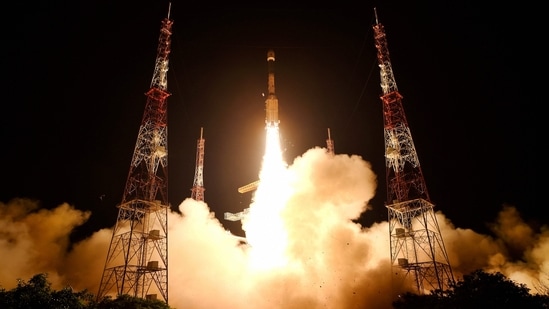Isro GISAT-1 failure: All you need to know about anomaly in cryogenic stage
The 51.70-metre tall rocket lifted off as planned at 05.43am, and its performance in the first and second stages was normal, Isro said. But minutes after the launch, the space agency said there the engines failed to ignite in the cryogenic stage.
The Indian Space Research Organisation (Isro) suffered a setback on Thursday after it failed to place an observation satellite into orbit. The Geosynchronous Satellite Launch Vehicle (GSLV) F10 rocket carrying GISAT-1 Earth observation satellite (EOS-03) successfully blasted off from the spaceport in Odisha. But a "performance anomaly" made the mission unsuccessful.

That anomaly was observed in the cryogenic stage, said Isro chairman K Sivan.
The 51.70-metre tall rocket lifted off as planned at 05.43am, and its performance in the first and second stages was normal, the space agency said.
Watch: Isro's GSLV blasts off but 'tech anomaly' cuts off mission
What are the stages of rocket launch?
A rocket launch has been divided by space agencies across the world in stages, where different thrusters and others parts help a vehicle reach desired destination in space. Depending on the distance to be covered, the space vehicle can go upto five stages, but broadly there are three. The heaviest part is the first stage, which uses the largest rocket engines the largest fuel and oxidiser tanks, and the highest thrust. Its task is to impart the initial thrust needed to overcome Earth's gravity.
After the fuel in first stage thrusters is used up, they detach and fall back on Earth, either in ocean or sparsely populated areas. The second stage now kicks in, with separate rocket engines and propellants which continues to accelerate the vehicle.
This engine too detaches itself after the intended use and falls back towards the Earth. But this time, the parts mostly disintegrate and evaporate after encountering atmospheric heating on its fall back toward Earth. The third stage then kicks in to help the space vehicle gain orbital velocity. Each of these stages are lighter than its predecessor and the entire operation is monitored by a mission control centre.
The GSLV used by Isro for today's launch was a four-stage rocket.
What is the cryogenic stage?
A cryogenic stage is the last stage of space launch vehicles, which makes use of cryogenics. The word refers to technology of sub-zero temperature where production and behaviour of materials is studied at below -150 degree Centigrade.
According to Isro website, a cryogenic rocket stage is more efficient and provides more thrust for every kilogram of propellant it burns compared to solid and earth-storable liquid propellant rocket stages.
However, cryogenic stage is technically a very complex system compared to solid or earth-storable liquid propellant stages due to its use of propellants at extremely low temperatures and the associated thermal and structural problems.
The anomaly in cryogenic stage
Minutes after the rocket launched early on Thursday morning, the scientists were seen in discussion and it was announced in the mission control centre by the range operations director that the mission could not be accomplished fully.
The engines failed to ignite in the cryogenic stage, according to Isro, which called it a "technical anomaly". "The mission couldn't be accomplished as intended," the space agency said on Twitter.
The intended aim of Isro's mission
The objective of Thursday's mission was to provide near real-time imaging of large area regions at frequent intervals, for quick monitoring of natural disasters, episodic events and obtain spectral signatures for agriculture, forestry, water bodies as well as for disaster warning, cyclone monitoring, cloud burst and thunderstorm monitoring.
Before today's launch, Isro had launched Brazil's earth observation satellite Amazonia-1 and 18 co-passenger satellites in February this year. Thursday's rocket launch was also planned to be held in April or May however, the Covid-19 outbreak pushed the scientists to resume it in August.






